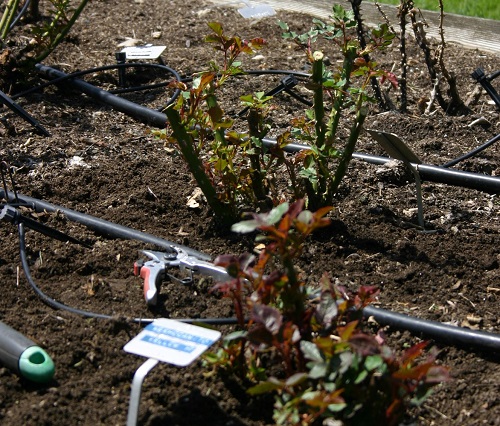
April is a banner month for rosarians everywhere. In warm climates, it’s time for first bloom, that glorious moment when all the roses bloom at the same time, for an incredible display. To promote a fast repeat and encourage flowers that are bigger and have sturdier stems, remove the spent blooms promptly, and cut them off with long stems. Roses love to be pruned, and pruning includes deadheading and cutting flowers. Don’t be a pruning wimp! Harsh deadheading will keep your plants strong and healthy and within the boundaries you’ve allowed for them.
Modern roses grow and bloom all season long, and they use a lot of photosynthetic energy to do so. This means that they need a steady supply of nutrients, so be sure to feed them frequently. Use organic fertilizers, which are vital to keeping the soil healthy but provide little in the way of nutritional value for the plants, as well as chemical fertilizers, which deliver the large quantities of the nutrients roses consume. Buy a fertilizer that’s formulated specifically for roses. It will contain the macro-nutrients, nitrogen, phosphorus, and potash (N-P-K) as well as the micro-nutrients, or trace elements, that roses need to achieve the rapid cell division that keeps them growing and blooming.
For rosarians who live where roses need protection from winter, April is our busiest time. It’s a lot of work, especially if you have a large rose garden, but it’s always a great feeling to get out into the garden after a long, non-green winter and see the beginnings of new growth as the bud eyes begin to wake up after a long dormancy. All our spring chores have to be done at the same time: removing the winter protection materials, spring pruning, planting the new roses, and doing the first-of-the-season applications that begin our regular fertilizer and pesticide regimens.
Pruning encourages roses to grow, so northern rosarians don’t prune their roses in the fall as they don’t want to stimulate new growth. They do it instead in the spring. The first thing to do is remove the winter protection materials. If you used soil or compost, you can leave it in the bed to add organic material to the soil. Remove leaves that haven’t broken down and other materials that make a good place for disease spores to hide. Gently pull the bulk of the soil mound away, but when you get close to the canes, it’s a good idea to use a gentle stream from the hose to wash the last of the soil away. New shoots will have started to grow under the soil mounds, so you want to be sure not to knock them off with your hands. I can’t tell you how many times I’ve done it, and it’s a horrible feeling!
After a cold, hard winter, there will be a lot of cane necrosis. The canes may, in fact, be dead right down to the point where the winter protection material covered the lower part of the canes, perhaps right down to the ground. Prune off all the dead parts, even if you must carefully dig into the soil to find live, green cane. Don’t worry! Those stubby little green canes will soon grow into tall healthy rosebushes.
You may see canes that are spotted with canker or dieback between the nodules of new growth. Don’t be fooled into thinking that the diseased cane is healthy even if it is putting out new growth. It’s not healthy and will continue to die back, so grit your teeth and prune down to clean green cane.
After pruning, spray all your plants with a good, all-purpose fungicide to disable any spores that may have settled on your roses over the winter.
Roses will grow fast from now on, so give them the fertilizer they need to make strong photosynthesis possible. Once every week or two, all season long, is not too often to feed modern everblooming roses.
Ann Hooper is a certified American Rose Society Consulting Rosarian.
Related Articles & Free Email Newsletter Sign Up
Struggling with Roses? Read the Directions and Try Again




Comment here